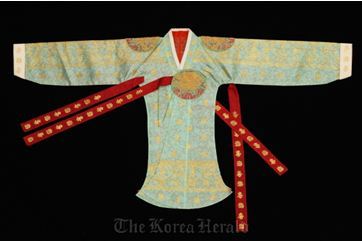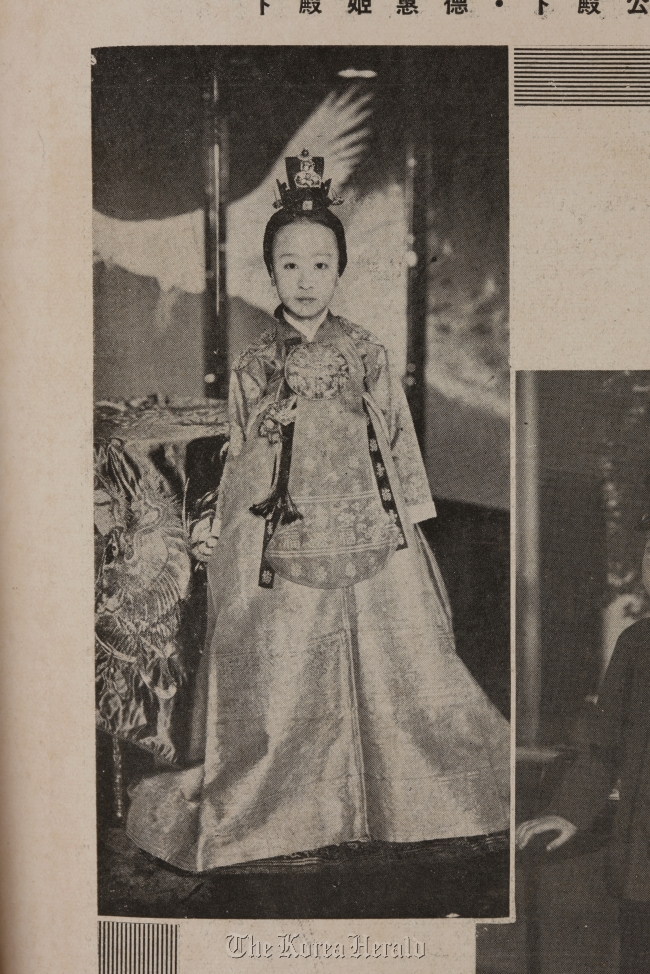 |
Dangeui, court woman’s ceremonial jacket. (National Palace Museum of Korea) |
Life of Deokhye (1912-1989), the last princess of the Joseon (1392-1910) Kingdom, was stranger and more dramatic than most fiction.
Born the youngest daughter of King Gojong (1852-1919,) she lost her beloved family at an early age. She began her struggle with premature dementia at the age of 18 and was forced to marry a Japanese aristocrat, which must have been a humiliation for the annexed royalty.
She was then sent to a facility for the mental disorder; her daughter ran away leaving a suicide note and her husband unilaterally decided on a divorce. She wasn’t able to return to her home country even after the liberation in 1945 as the Rhee Syngman government denied her entry. When she was finally allowed to return in 1962, she couldn’t recognize Korea. She died 28 years later.
 |
Young Princess Deokhye wearing a court woman’s ceremonial jacket. (National Palace Museum of Korea) |
A special exhibition at the National Palace Museum of Korea, “Last Princess Deokhye,” running through Jan. 27, highlights the tragic life of the princess and looks into the lifestyle of upper-class women of that time.
“The exhibition was organized to commemorate the 100th anniversary of the princess’ birth and the 50 years since her return to Korea,” said Jeong Jong-soo, director of the museum.
Some 108 items including Deokhye’s attire and belongings, as well as keepsakes are displayed for the first time ― 63 of them were borrowed from the Bunka Gakuen Costume Museum in Japan and 16 from Kyushu National Museum, also in Japan, while others were collected from different places in Korea.
“Through Deokhye’s keepsakes we will also be able to learn the lifestyle of infants, youths and young women in the early 20th century,” said Park Su-hee, the museum’s curator.
The exhibition is comprised of three sections ― the birth and childhood of the princess; her life in Japan; and her marriage and return to Korea. The rooms are colored in pink, purple and grey.
“It reflects the life of the princess. It was rosy at first and became dull,” Park said.
The first section shows how Deokhye’s birth was celebrated in the country. The princess was born two years after the country was annexed by Japan and the girl brought great joy to King Gojong who was already over 60 years old. Her photographs taken on her birthday, at the kindergarten established especially for her and with other members of the royal family show that the princess was very much cherished.
The royal attire in bright pink, green, purple, blue and red shows the fashion of upper-class women.
“The costumes were worn at weddings or very important occasions such as visits to the royal palace by high society women. The royal family wore it every day,” Park said.
The young princess, who became the darling of the nation with the press covering her every move on a daily basis, was forced to move to Japan at the age of 14. The Japanese government had already sent her older brother, Prince Yeong, to Japan in order to keep them away from the Korean public’s eye.
The second section shows the young princess’ struggle to survive in what she perceived as a hostile environment. Her letters to her brother, family in Korea and others are on display showing how a bubbly and smart girl grew into a reserved, depressed woman.
Photographs of the princess and Count Takeyuki So, a descendent of the clan lord of Tsushima Island who was selected to wed her, are also on display. Though she suffered from worsening illnesses the princess and her husband seemed to have gotten along well. There is a poem by So missing his “silent, beautiful, but insane” wife, revealing the agony of the man next to a woman who does not recognize him.
The return of Deokhye to Korea was facilitated after a Korean journalist, Kim Eul-hwan, urged the Korean government to approve her return. Kim’s letters to Prince Yeong and the Korean authorities are exhibited.
Nine days after Deokhye died, her sister-in-law and widow of Prince Yeong, Lee Bang-ja, passed away in the same Nakseonjae building in Changdeok Palace. The building was emptied ― there was no direct descendant left to reside there. This marked the official closure of the Joseon Kingdom era.
The exhibition is held from 9 a.m. through 6 p.m. and is closed every Monday.
By Bae Ji-sook (
baejisook@heraldcorp.com)









![[Today’s K-pop] Blackpink’s Jennie, Lisa invited to Coachella as solo acts](http://res.heraldm.com/phpwas/restmb_idxmake.php?idx=644&simg=/content/image/2024/11/21/20241121050099_0.jpg)